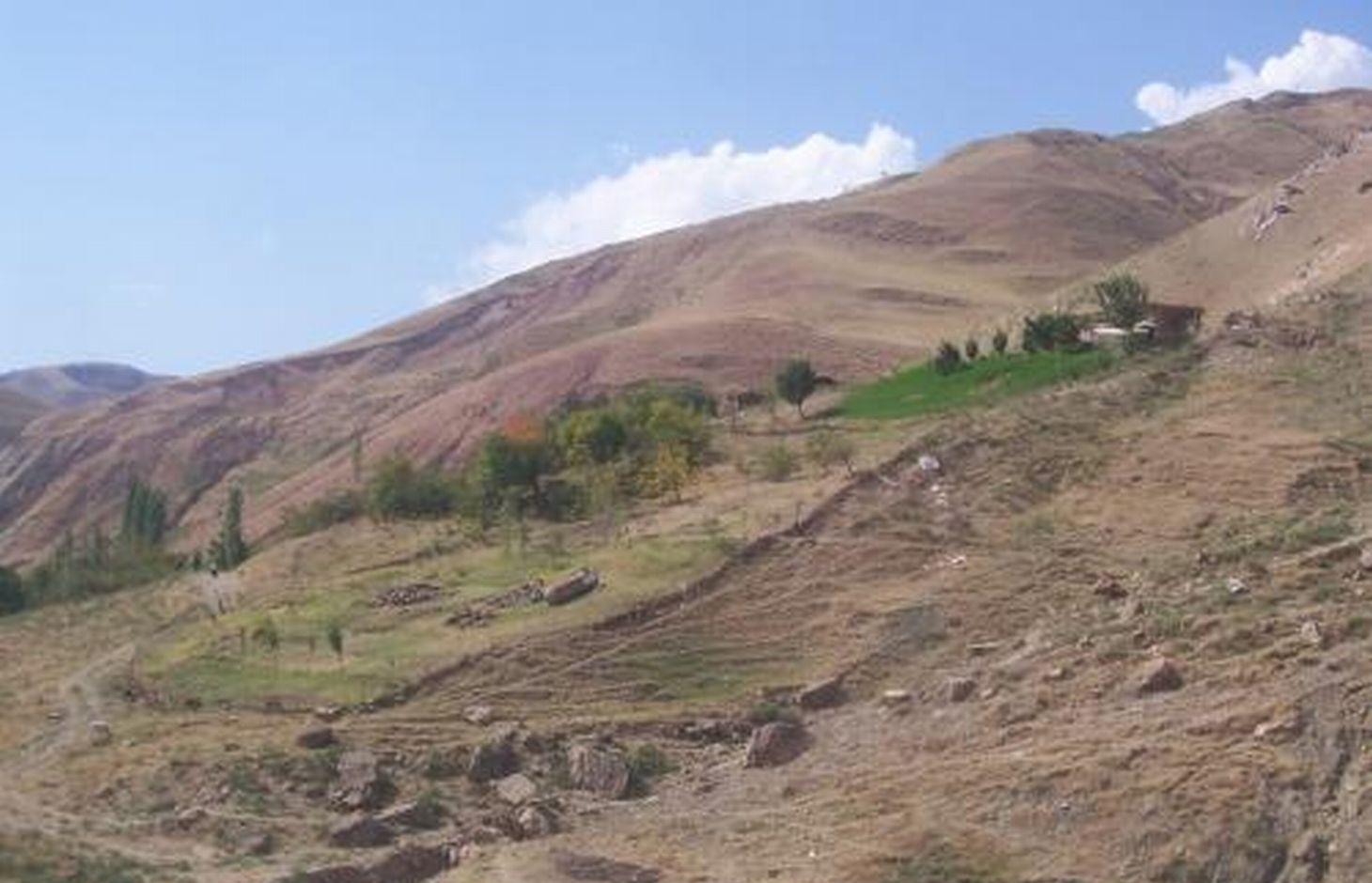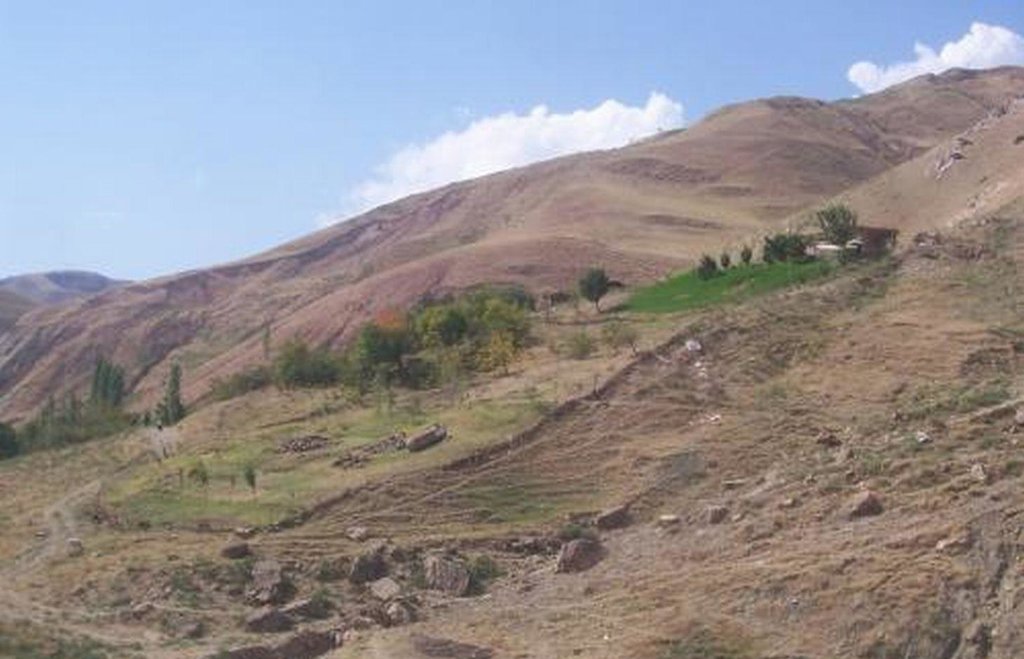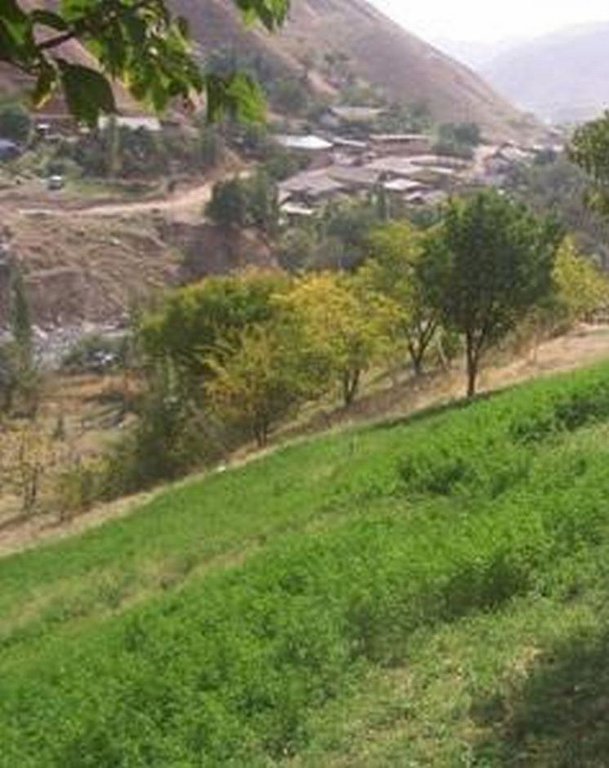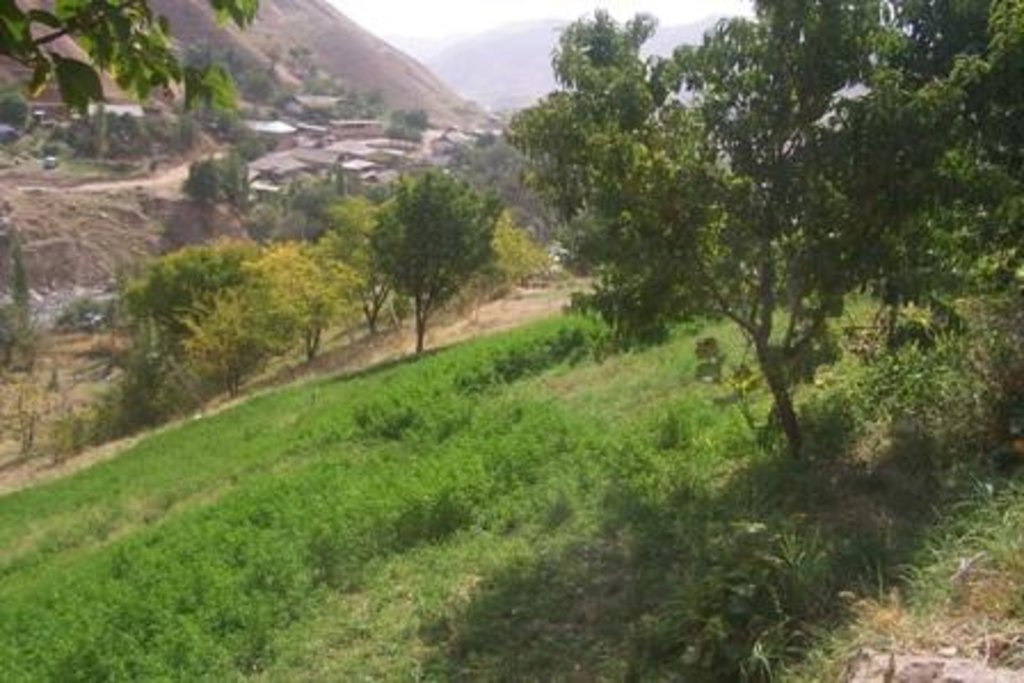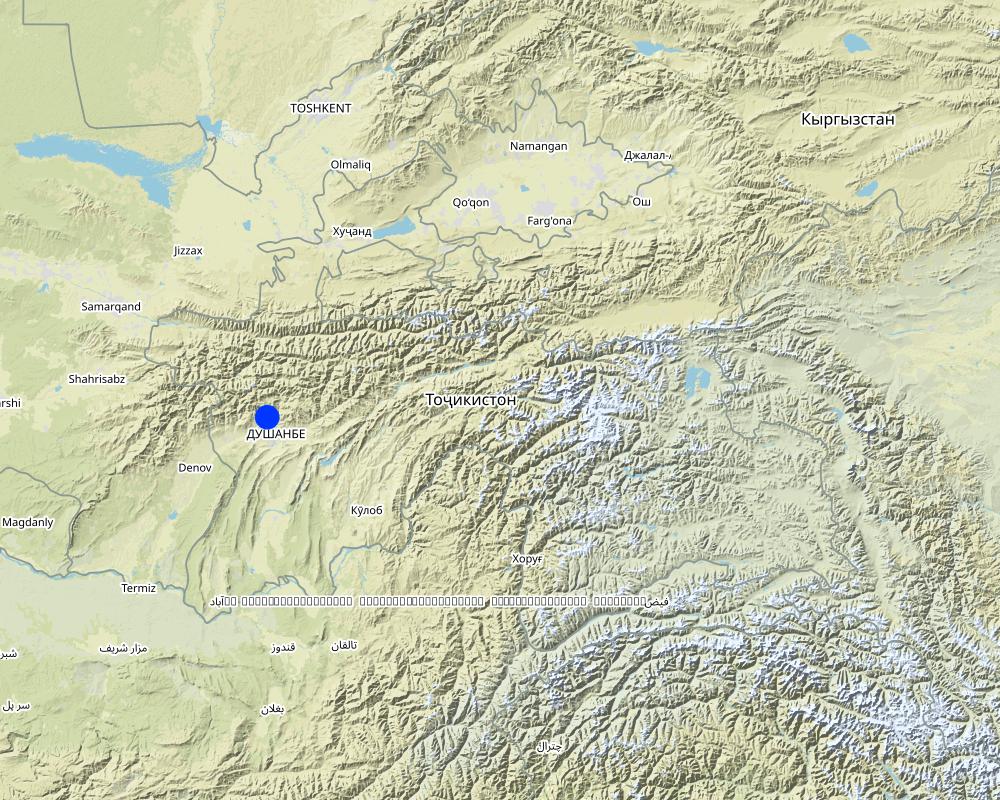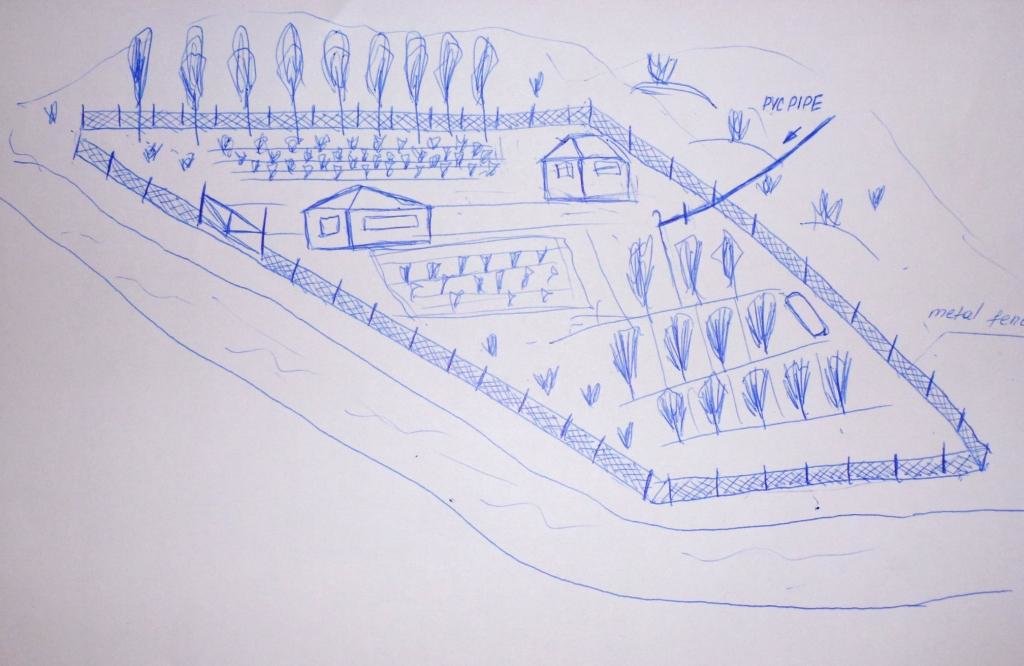Integrated Technologies for Household Plots [Tajiquistão]
- Criação:
- Atualização:
- Compilador/a: Habib Kamolidinov
- Editor: –
- Revisores: Alexandra Gavilano, David Streiff, Joana Eichenberger
technologies_1057 - Tajiquistão
- Resumo completo em PDF
- Resumo completo em PDF para impressão
- Resumo completo no navegador
- Resumo completo (sem formatação)
- Integrated Technologies for Household Plots: 20 de Março de 2017 (inactive)
- Integrated Technologies for Household Plots: 22 de Julho de 2017 (inactive)
- Integrated Technologies for Household Plots: 14 de Agosto de 2019 (inactive)
- Integrated Technologies for Household Plots: 2 de Novembro de 2021 (public)
Veja as seções
Expandir tudo Recolher tudo1. Informação geral
1.2 Detalhes do contato das pessoas capacitadas e instituições envolvidas na avaliação e documentação da tecnologia
Especialista em GST:
Nome do projeto que facilitou a documentação/avaliação da Tecnologia (se relevante)
Pilot Program for Climate Resilience, Tajikistan (WB / PPCR)Nome da(s) instituição(ões) que facilitou(ram) a documentação/ avaliação da Tecnologia (se relevante)
GITEC/ADB/DMC Rural Development Project Land Management Institute - Tajiquistão1.3 Condições em relação ao uso da informação documentada através de WOCAT
O compilador e a(s) pessoa(s) capacitada(s) aceitam as condições relativas ao uso de dados documentados através do WOCAT:
Sim
2. Descrição da tecnologia de GST
2.1 Descrição curta da tecnologia
Definição da tecnologia:
A fenced enclosure transformed with stone clearing and a small scale irrigation system, to grow a wide range of perennial, annual and orchard crops, beekeeping and small scale animal production.
2.2 Descrição detalhada da tecnologia
Descrição:
A small area of previously severely eroded and almost devoid of vegetation area of land that was transformed through the building a perimeter fence, supplying a simple irrigation system and the planting of a diverse range of crops to provide a rich, integrated farming system. Activities then completed on this area included: orchard planting, perennial fodder crops (lucerne), garden vegetables, bee keeping for honey production and small scale animal rearing.
Purpose of the Technology: The farmer clearly stated that his prime, initial purpose in taking over this “ruined and abandoned land” was to improve and better guarantee the quality of his family’s lifestyle through enhanced and assured food and fodder production. He also recognised the potential for future profit through sale of his excess produce to market. Currently, the family has almost no need to buy food (and fodder) from nearby markets, apart from flour for bread making. This is a large cost saving. In hindsight, the farmer sees that he has dramatically improved land quality within the enclosure through mitigating erosion and increasing year-round vegetation cover.
Establishment / maintenance activities and inputs: The family (Enomali is the family name) first occupied this land in 1984. The first task was tree planting – a variety of orchard trees – on 0.1 ha of the current enclosure. This was fenced using abandoned wire and metal supports from old Russian factories. After nine family members left (to work in Dushanbe) the land user expanded the fence to the current 0.2 ha and continued to plant trees. He continued the stone removal through the 1990s and even up until the present day. Lucerne and vegetable gardens were initiated in the 1990s and continue to be enriched as required. Fodder, tree and vegetable production includes an ongoing set of tasks, as does the animal feeding with the home-grown fodder. Bee keeping is seasonal and the honey kept for home consumption. The land user continues to plant orchard trees every year and currently has more than 100. He gained a “certificate” of ownership” in 2008.
Natural / human environment: Before the family occupied this land, the land user stated that it was “totally ruined and abandoned”. That is why it was unoccupied. The family were prepared to work extremely hard to convert this ruined land to the green and productive “island” that it now is. The people in the area are dependent upon the produce of the land, however suitable land is in short supply and subject to population pressures.
2.3 Fotos da tecnologia
2.5 País/região/locais onde a tecnologia foi aplicada e que estão cobertos nesta avaliação
País:
Tajiquistão
Região/Estado/Província:
Central District of Tajikistan
Especificação adicional de localização:
Varzob
Especifique a difusão da tecnologia:
- Uniformemente difundida numa área
Se a área precisa não for conhecida, indicar a área aproximada coberta:
- < 0,1 km2 (10 ha)
Comentários:
The small area was all that the family could manage as there was an initial large workload, clearing stones and fence building, etc
Map
×2.6 Data da implementação
Caso o ano exato seja desconhecido, indique a data aproximada:
- 10-50 anos atrás
2.7 Introdução da tecnologia
Especifique como a tecnologia foi introduzida:
- atráves de inovação dos usuários da terra
Comentários (tipos de projeto, etc.):
The land user developed the integrated approach to implentation of the technology.
3. Classificação da tecnologia de GST
3.1 Principal/principais finalidade(s) da tecnologia
- Melhora a produção
- rehabilitate severely degraded land
3.2 Tipo(s) atualizado(s) de uso da terra onde a tecnologia foi aplicada
Uso do solo misturado dentro da mesma unidade de terra:
Sim
Especificar o uso misto da terra (culturas/ pastoreio/ árvores):
- Agrofloresta

Terra de cultivo
- Cultura anual
- Cultura perene (não lenhosa)
- Cultura de árvores e arbustos
Cultivo anual - Especificar culturas:
- culturas forrageiras - outros
- vegetables, orchard fruits, lucerne
Número de estações de cultivo por ano:
- 1
Especifique:
Longest growing period in days: 180Longest growing period from month to month: April to September

Pastagem
Pastagem intensiva/produção de forragem:
- Semiestabulação/sem pastagem

Floresta/bosques
Produtos e serviços:
- Frutas e nozes
Comentários:
Livestock density (if relevant):
< 1 LU/km2
Major land use problems (compiler’s opinion): Massive water erosion causing gullies, sheet washing and landslides. This leads to land denudation of the soil and vegetation. Almost total lack of soil organic matter and above/below ground biodiversity. No water holding capacity of the land – combination of steep slopes and no vegetation causes all rainwater to immediately runoff.
Major land use problems (land users’ perception): Same – the above words were used by the farmer in the on-farm interview.
Cut-and-carry/ zero grazing: Yes
Other type of forest: orchard species
Forest products and services: fruits and nuts
Future (final) land use (after implementation of SLM Technology): Mixed: Mf: Agroforestry
3.3 O uso do solo mudou devido à implementação da Tecnologia?
O uso do solo mudou devido à implementação da Tecnologia?
- Sim (Por favor, preencha as perguntas abaixo com relação ao uso do solo antes da implementação da Tecnologia)
Uso do solo misturado dentro da mesma unidade de terra:
Sim
Especificar o uso misto da terra (culturas/ pastoreio/ árvores):
- Agrofloresta

Pastagem
Comentários:
Grazing land: Ge: Extensive grazing land
3.4 Abastecimento de água
Abastecimento de água para a terra na qual a tecnologia é aplicada:
- Misto de precipitação natural-irrigado
3.5 Grupo de GST ao qual pertence a tecnologia
- Agrofloresta
- Solo/cobertura vegetal melhorada
- variedades vegetal/raças de animais melhoradas
3.6 Medidas de GST contendo a tecnologia

Medidas agronômicas
- A1: cobertura vegetal/do solo

Medidas vegetativas
- V1: cobertura de árvores/arbustos

Medidas estruturais
- S6: Muros, barreiras, paliçadas, cercas

Medidas de gestão
- M1: Mudança no tipo de uso da terra
Comentários:
Main measures: agronomic measures, vegetative measures, structural measures
Type of agronomic measures: better crop cover, mixed cropping / intercropping, cover cropping, retaining more vegetation cover, furrows (drainage, irrigation)
Type of vegetative measures: in blocks
3.7 Principais tipos de degradação da terra abordados pela tecnologia

Erosão do solo pela água
- Wt: Perda do solo superficial/erosão de superfície
- Wg: Erosão por ravinas/ravinamento
- Wm: movimento de massas/deslizamentos

Degradação biológica
- Bc: redução da cobertura vegetal
- Bh: perda dos habitats
- Bq: quantidade/ declínio da biomassa
- Bl: perda da vida do solo
Comentários:
Main type of degradation addressed: Wt: loss of topsoil / surface erosion, Wg: gully erosion / gullying, Wm: mass movements / landslides, Bc: reduction of vegetation cover, Bl: loss of soil life
Secondary types of degradation addressed: Bh: loss of habitats, Bq: quantity / biomass decline
Main causes of degradation: deforestation / removal of natural vegetation (incl. forest fires) (Post Soviet era – massive forest clearing for firewood), over-exploitation of vegetation for domestic use (Exploitation of fire wood.), overgrazing (massive overgrazing of an already depleted land resource), other natural causes (avalanches, volcanic eruptions, mud flows, highly susceptible natural resources, extreme topography, etc.) specify (Loess landscape – highly susceptible to water erosion – massively exacerbated by vegetation clearing (tree chopping and animal grazing))
Secondary causes of degradation: population pressure, poverty / wealth, war and conflicts (increased natural resource pressure during the civil war.)
3.8 Redução, prevenção ou recuperação da degradação do solo
Especifique o objetivo da tecnologia em relação a degradação da terra:
- Recuperar/reabilitar solo severamente degradado
Comentários:
Secondary goals: prevention of land degradation, mitigation / reduction of land degradation
4. Especificações técnicas, implementação de atividades, entradas e custos
4.1 Desenho técnico da tecnologia
Especificações técnicas (relacionada ao desenho técnico):
The drawing shows an enclosed area, a fence line consisting of wire fencing, brush and scrap metal materials. At the top of the slope a row of fast growing poplars was planted to protect the enclosure and the adjacent vegetable plot from the wind and rain. Perenials are intercropped with fruit trees further below the dwelling and the area is fed by an irrigation pipe originating from a local spring.
Location: Tajikistan. Varzob, Luchob
Date: 28 April 2011
Technical knowledge required for field staff / advisors: moderate (If training was provided to replicate the technology.)
Technical knowledge required for land users: moderate
Main technical functions: control of raindrop splash, control of dispersed runoff: impede / retard, improvement of ground cover, improvement of topsoil structure (compaction), increase in nutrient availability (supply, recycling,…), increase / maintain water stored in soil, increase of biomass (quantity), promotion of vegetation species and varieties (quality, eg palatable fodder)
Secondary technical functions: increase of surface roughness, improvement of surface structure (crusting, sealing), increase in organic matter, increase of infiltration, water spreading, improvement of water quality, buffering / filtering water, reduction in wind speed, spatial arrangement and diversification of land use
Better crop cover
Material/ species: Perennial lucerne for fodder
Quantity/ density: 100% cover
Remarks: 0.1 ha
Cover cropping
Material/ species: Lucerne is a cover crop
Retaining more vegetation cover
Material/ species: Land previously bare
Agronomic measure: other
Material/ species: Perennial legume pasture species - lucerne
Quantity/ density: 0.1 ha
Furrows (drainage, irrigation)
Material/ species: Irrigation via hand cut 20cm cube ditches and poly pipe
Aligned: -contour
Vegetative material: T : trees / shrubs
Scattered / dispersed
Vegetative material: T : trees / shrubs
In blocks
Number of plants per (ha): 100%
Vertical interval between rows / strips / blocks (m): about 0.1 ha planted
Fruit trees / shrubs species: Apple, cherry, apricot, pear
Perennial crops species: lucerne
Other species: Vegetable garden
Slope (which determines the spacing indicated above): 38.30%
Gradient along the rows / strips: 5.24%
Wall/ barrier
Depth of ditches/pits/dams (m): 1
Length of ditches/pits/dams (m): 1000
Slope (which determines the spacing indicated above): 21 degrees – measured with cli%
Lateral gradient along the structure: 3 degrees%
Autor:
Habib Kamolidinov, Land Management Institute, Giprozem 15, Dushanbe, Tajikistan
4.2 Informação geral em relação ao cálculo de entradas e custos
Outro/moeda nacional (especifique):
somoni
Se for relevante, indique a taxa de câmbio do USD para moeda local (por exemplo, 1 USD = 79,9 Real): 1 USD =:
4,5
Indique a média salarial da mão-de-obra contratada por dia:
5.50
4.3 Atividades de implantação
| Atividade | Periodicidade (estação do ano) | |
|---|---|---|
| 1. | Fence building | At the start |
| 2. | Irrigation pipes | At the start |
| 3. | Tree planting | At the start |
| 4. | Cover cropping (lucerne replanting) | annually |
| 5. | Small vegetable beds | annually |
| 6. | Vegetable garden | annually |
4.4 Custos e entradas necessárias para a implantação
| Especifique a entrada | Unidade | Quantidade | Custos por unidade | Custos totais por entrada | % dos custos arcados pelos usuários da terra | |
|---|---|---|---|---|---|---|
| Mão-de-obra | Fence building | Persons/day | 100,0 | 25,0 | 2500,0 | 100,0 |
| Mão-de-obra | Tree planting | Persons/day | 10,0 | 25,0 | 250,0 | 100,0 |
| Mão-de-obra | Cover cropping | Persons/day | 5,0 | 25,0 | 125,0 | 100,0 |
| Mão-de-obra | Vegetable garden | Persons/day | 50,0 | 25,0 | 1250,0 | 100,0 |
| Material vegetal | Trees | Pieces | 50,0 | 10,0 | 500,0 | 100,0 |
| Material vegetal | Plants | Pieces | 3000,0 | 0,33333333 | 1000,0 | 100,0 |
| Material de construção | Fence | meter | 200,0 | 2,25 | 450,0 | 100,0 |
| Material de construção | Irrigation pipe | meter | 1500,0 | 1,5 | 2250,0 | 100,0 |
| Outros | Labour: Small vegetable beds | Persons/day | 20,0 | 25,0 | 500,0 | 100,0 |
| Custos totais para a implantação da tecnologia | 8825,0 | |||||
| Custos totais para o estabelecimento da Tecnologia em USD | 1961,11 | |||||
Comentários:
Duration of establishment phase: 48 month(s)
4.5 Atividades recorrentes/manutenção
| Atividade | Periodicidade/frequência | |
|---|---|---|
| 1. | Better crop cover and cover cropping | Annually |
| 2. | Stone clearing | Annually |
| 3. | Vegetable garden | Annually |
| 4. | Animal husbandry (and bee keeping) | Annual |
| 5. | Fertilising (garden vegetables) | Annual |
| 6. | Tree planting | Annually |
| 7. | Lucerne reseeding | Annually |
| 8. | Vegetable planting | Annually |
| 9. | Small vegetable beds | Annual |
4.6 Custos e entradas necessárias pata a manutenção/atividades recorrentes (por ano)
| Especifique a entrada | Unidade | Quantidade | Custos por unidade | Custos totais por entrada | % dos custos arcados pelos usuários da terra | |
|---|---|---|---|---|---|---|
| Mão-de-obra | Better crop cover and cover cropping | Persons/day | 10,0 | 25,0 | 250,0 | 100,0 |
| Mão-de-obra | Stone clearing | Persons/day | 10,0 | 25,0 | 250,0 | 100,0 |
| Mão-de-obra | Vegetable garden incl. fertilizing | Persons/day | 15,0 | 25,0 | 375,0 | 100,0 |
| Mão-de-obra | Animal husbandry (and bee keeping) | Persons/day | 40,0 | 25,0 | 1000,0 | 100,0 |
| Outros | Labour: Tree planting | Persons/day | 10,0 | 25,0 | 250,0 | 100,0 |
| Outros | Labour: Lucerne reseeding | Persons/day | 10,0 | 25,0 | 250,0 | 100,0 |
| Outros | Labour: Vegetable planting | Persons/day | 50,0 | 25,0 | 1250,0 | 100,0 |
| Outros | Labour: Preparing small vegetable beds | Persons/day | 20,0 | 25,0 | 500,0 | 100,0 |
| Custos totais para a manutenção da tecnologia | 4125,0 | |||||
| Custos totais de manutenção da Tecnologia em USD | 916,67 | |||||
Comentários:
Machinery/ tools: All work is done manually. There is one mule available to aid with carrying fodder and rocks., All works done manually. Mule assists with heavy lifting and carrying.
The area is approximately one hectare in total, however the costs are spread over a period of time up to 2010.
4.7 Fatores mais importantes que afetam os custos
Descreva os fatores mais determinantes que afetam os custos:
The human labour costs (I believe) are most misleading. The farmer and his family happily and willingly committed their time and effort over a period of 27 years to improving this piece of land – as they knew that their family lifestyle would vastly improve and be greatly assured through their efforts. As the farmer said during the interview: “What else would I be doing?” Meaning – this is his life and he thoroughly enjoyed the inputs, realising the richness of the outputs.
Fence costs were minimal (a few hundred dollars) as on departure of the Russians after the Soviet period, the factories were ransacked by locals for metals of all types, not a sustainable practice, but at this time gave locals access to free materials to use. In this case for fencing.
Trees – there was an initial set up cost and the farmer said he tries to plant at least 20 new trees each year to maintain and enhance productivity.
Lucerne – there was a set up cost (farmer forgets how much – but approx. $50) for seed. But now the lucerne is almost self-regenerating (from it's own seeds) as the last cut each year is for seed production that the farmer spreads in the lucerne field.
5. Ambiente natural e humano
5.1 Clima
Precipitação pluviométrica anual
- <250 mm
- 251-500 mm
- 501-750 mm
- 751-1.000 mm
- 1.001-1.500 mm
- 1.501-2.000 mm
- 2.001-3.000 mm
- 3.001-4.000 mm
- > 4.000 mm
Especificações/comentários sobre a pluviosidade:
Dominate in Spring (March-May) The period June to September is very hot and dry (almost no rainfall)
Zona agroclimática
- Semiárido
Thermal climate class: temperate
5.2 Topografia
Declividade média:
- Plano (0-2%)
- Suave ondulado (3-5%)
- Ondulado (6-10%)
- Moderadamente ondulado (11-15%)
- Forte ondulado (16-30%)
- Montanhoso (31-60%)
- Escarpado (>60%)
Formas de relevo:
- Planalto/planície
- Cumes
- Encosta de serra
- Encosta de morro
- Sopés
- Fundos de vale
Zona de altitude:
- 0-100 m s.n.m.
- 101-500 m s.n.m.
- 501-1.000 m s.n.m.
- 1.001-1.500 m s.n.m.
- 1.501-2.000 m s.n.m.
- 2.001-2.500 m s.n.m.
- 2.501-3.000 m s.n.m.
- 3.001-4.000 m s.n.m.
- > 4.000 m s.n.m.
Indique se a tecnologia é aplicada especificamente em:
- Posições convexas
Comentários e outras especificações sobre a topografia:
Altitudinal zone: The site is exactly at 1,180 meters a.s.l.
5.3 Solos
Profundidade do solo em média:
- Muito raso (0-20 cm)
- Raso (21-50 cm)
- Moderadamente profundo (51-80 cm)
- Profundo (81-120 cm)
- Muito profundo (>120 cm)
Textura do solo (solo superficial):
- Médio (limoso, siltoso)
Matéria orgânica do solo superficial:
- Alto (>3%)
Caso disponível anexe a descrição completa do solo ou especifique as informações disponíveis, p. ex. tipo de solo, PH/acidez do solo, nitrogênio, capacidade de troca catiônica, salinidade, etc.
Soil texture: Loess soil – silty loam
Soil fertility is high with proper management (as in intervention) these soils are very fertile. Before the intervention –extremely low fertility
Topsoil organic matter was before intervention <1%
Soil water storage capacity is medium
5.4 Disponibilidade e qualidade de água
Lençol freático:
5-50 m
Disponibilidade de água de superfície:
Bom
Qualidade da água (não tratada):
Água potável boa
Comentários e outras especificações sobre a qualidade e a quantidade da água:
Availability of surface water was medium before the intervention.
Water quality (untreated) is good because the spring water is almost pure water.
5.5 Biodiversidade
Diversidade de espécies:
- Médio
Comentários e outras especificações sobre biodiversidade:
But it will have improved with intervention through dramatically increased vegetation cover
5.6 Características dos usuários da terra que utilizam a tecnologia
Orientação de mercado do sistema de produção:
- Subsistência (autoabastecimento)
Rendimento não agrícola:
- 10-50% de toda renda
Indivíduos ou grupos:
- Indivíduo/unidade familiar
Nível de mecanização:
- Trabalho manual
- Tração animal
Indique outras características relevantes dos usuários da terra:
Difference in the involvement of women and men: There is not a great difference. The farmer’s wife shares the workload but tends to focus more on the garden, fruit production, household duties and bee keeping. The farmer generally conducts hay cutting and gathering, stone removal, fence upkeep and animal tending (feeding and slaughtering when required).
Population density: < 10 persons/km2
Annual population growth: 1% - 2%
10% of the land users are average wealthy.
80% of the land users are poor.
10% of the land users are poor.
Off-farm income specification: The issue is that it tends to be the older and very young family members (ie Mr Enomali and his wife are in their late 50s, and their pre-school age grandchildren stay with them) stay on the farm. The others (18 to 50 yrs old) have paid employment in Dushanbe and Russia – and only visit the farm occasionally. However, it is believed they part-finance (contribute) to the upkeep of the family farm.
Market orientation of production system: All of the farm produce stays on the farm for home consumption, but they do eat well and very healthy (fresh and organic) food.
Level of mechanization: Normally manual but with one mule to help with heavy work.
5.7 Área média de terrenos utilizados pelos usuários de terrenos que aplicam a Tecnologia
- < 0,5 ha
- 0,5-1 ha
- 1-2 ha
- 2-5 ha
- 5-15 ha
- 15-50 ha
- 50-100 ha
- 100-500 ha
- 500-1.000 ha
- 1.000-10.000 ha
- > 10.000 ha
5.8 Propriedade de terra, direitos de uso da terra e de uso da água
Propriedade da terra:
- Estado
Direitos do uso da terra:
- Indivíduo
Comentários:
Not yet an issue – as he is the only one with access to the spring water.
5.9 Acesso a serviços e infraestrutura
Saúde:
- Pobre
- Moderado
- Bom
Educação:
- Pobre
- Moderado
- Bom
Assistência técnica:
- Pobre
- Moderado
- Bom
Emprego (p. ex. não agrícola):
- Pobre
- Moderado
- Bom
Mercados:
- Pobre
- Moderado
- Bom
Energia:
- Pobre
- Moderado
- Bom
Vias e transporte:
- Pobre
- Moderado
- Bom
Água potável e saneamento:
- Pobre
- Moderado
- Bom
Serviços financeiros:
- Pobre
- Moderado
- Bom
6. Impactos e declarações finais
6.1 Impactos no local mostrados pela tecnologia
Impactos socioeconômicos
Produção
Produção agrícola
Quantidade anterior à GST:
0
Comentários/especificar:
Prior to the technology this land was “ruined, denuded wasteland” that had almost no carrying capacity, no productivity and no water supply, so the % increase as a result of the technology is from a starting point of zero.
Produção de forragens
Quantidade anterior à GST:
0
Qualidade da forragem
Quantidade anterior à GST:
0
Produção animal
Quantidade anterior à GST:
2
Produção de madeira
Quantidade anterior à GST:
0
Risco de falha de produção
Quantidade anterior à GST:
0
Diversidade de produtos
Quantidade anterior à GST:
0
Área de produção
Quantidade anterior à GST:
0
Gestão de terra
Quantidade anterior à GST:
0
Disponibilidade e qualidade de água
Disponibilidade de água potável
Quantidade anterior à GST:
0
Disponibilidade de água para criação de animais
Qualidade da água para criação de animais
Disponibilidade de água para irrigação
Qualidade da água para irrigação
Renda e custos
Despesas com insumos agrícolas
Quantidade anterior à GST:
0
Rendimento agrícola
Quantidade anterior à GST:
0
Diversidade de fontes de rendimento
Quantidade anterior à GST:
0
Carga de trabalho
Impactos socioculturais
Segurança alimentar/auto-suficiência
Estado de saúde
Oportunidades culturais
Oportunidades de lazer
Conhecimento de GST/ degradação da terra
Situação de grupos social e economicamente desfavorecidos
Livelihood and human well-being
Comentários/especificar:
The primary aim of the farmer in introducing the Technology was to improve the family’s lifestyle and well being. He has easily achieved this and it seems to be getting better, year on year. The family have improved their food security and quality.
Impactos ecológicos
Ciclo hídrico/escoamento
Quantidade de água
Quantidade anterior à GST:
0
Qualidade de água
Quantidade anterior à GST:
0
Colheita/recolhimento de água
Quantidade anterior à GST:
0
Escoamento superficial
Quantidade anterior à GST:
0
Drenagem de excesso de água
Quantidade anterior à GST:
0
Evaporação
Quantidade anterior à GST:
0
Solo
Umidade do solo
Quantidade anterior à GST:
0
Cobertura do solo
Quantidade anterior à GST:
0
Perda de solo
Quantidade anterior à GST:
0
Ressecamento/ selagem do solo
Quantidade anterior à GST:
0
Compactação do solo
Quantidade anterior à GST:
0
Ciclo e recarga de nutrientes
Quantidade anterior à GST:
0
Biodiversidade: vegetação, animais
Biomassa/carbono acima do solo
Quantidade anterior à GST:
0
Diversidade vegetal
Quantidade anterior à GST:
0
Outros impactos ecológicos
Hazard towards adverse events
6.2 Impactos externos mostrados pela tecnologia
Disponibilidade de água
Quantidade anterior à GST:
0
Caudal confiável e estável em período seco
Cheias de jusante
Comentários/especificar:
As the Technology has so revolutionised the productive capacity and sustainability of the site, there are no obvious disadvantages.
Sedimentação a jusante
Capacidade de tamponamento/filtragem
Danos em áreas vizinhas
6.3 Exposição e sensibilidade da tecnologia às mudanças climáticas graduais e extremos/desastres relacionados ao clima (conforme o ponto de vista dos usuários da terra)
Mudança climática gradual
Mudança climática gradual
| Estação do ano | aumento ou diminuição | Como a tecnologia lida com isso? | |
|---|---|---|---|
| Temperatura anual | aumento | bem |
Extremos (desastres) relacionados ao clima
Desastres meteorológicos
| Como a tecnologia lida com isso? | |
|---|---|
| Temporal local | bem |
| Tempestade de vento local | bem |
Desastres climatológicos
| Como a tecnologia lida com isso? | |
|---|---|
| Seca | bem |
Desastres hidrológicos
| Como a tecnologia lida com isso? | |
|---|---|
| Inundação geral (rio) | não conhecido |
Outras consequências relacionadas ao clima
Outras consequências relacionadas ao clima
| Como a tecnologia lida com isso? | |
|---|---|
| Período de crescimento reduzido | bem |
6.4 Análise do custo-benefício
Como os benefícios se comparam aos custos de implantação (do ponto de vista dos usuários da terra)?
Retornos a curto prazo:
negativo
Retornos a longo prazo:
muito positivo
Como os benefícios se comparam aos custos recorrentes/de manutenção(do ponto de vista dos usuários da terra)?
Retornos a curto prazo:
muito positivo
Retornos a longo prazo:
muito positivo
Comentários:
The establishment and ongoing costs are very small in comparison to the long and short term benefits. If natural materials cannot be used for fencing materials, then the initial establishment costs will be higher.
6.5 Adoção da tecnologia
- casos isolados/experimental
Se disponível, determine a quantidade (número de unidades familiares e/ou área abordada):
1 household
De todos aqueles que adotaram a Tecnologia, quantos o fizeram espontaneamente, ou seja, sem receber nenhum incentivo/ pagamento material?
- 91-100%
Comentários:
100% of land user families have adopted the Technology without any external material support
There is a little trend towards spontaneous adoption of the Technology
Comments on adoption trend: There are (seemingly) quite a few enclosures already in this area – but these have not been reviewed.
6.7 Pontos fortes/vantagens/oportunidades da tecnologia
| Pontos fortes/vantagens/oportunidades na visão do usuário da terra |
|---|
|
The land provided food security and a small income for my family. How can they be sustained / enhanced? To replicate it, maybe small grants and loans could be awarded. |
| Pontos fortes/vantagens/oportunidades na visão do compilador ou de outra pessoa capacitada |
|---|
|
The fence building started and underpins the whole SLM initiative. That it was achieved by only 2-3 people, in a one year period and at low cost (using mainly scrap materials) adds to the strengths. How can they be sustained / enhanced? The farmer wishes to expand his fenced area so the enclosure is 1 ha in size |
|
Bringing water to the site (at his own cost) by poly pipe was a critical part to the technology. The land in the enclosure would probably have improved anyway, due to animal exclusion, but this was greatly improved by the provison of irrigation water. This is relatively a small volume of water, but it is available all year round which is key to the plants being able to survive through the hot summer months. How can they be sustained / enhanced? The farmer wishes to source a 2nd spring to water the extended (1 ha) site |
|
The rich mix of vegetation on the site (trees, perennial fodder legume and vegetable production) not only ensures the intervention remains viable but also ensures a continuous, rich, healthy food supply to the family all year round How can they be sustained / enhanced? The farmer has already started to plant new fruit trees outside the fence area, in readiness for moving the fence to encompass a 1 ha site |
|
Clearing stones was an important technological input, to greatly increase the available “growth area” for the introduced plants and trees as well as maintain soil depth. Linked to the irrigation system, the increased soil depth has greatly aided the vitality of this SLM approach – especially in the hot summer months. How can they be sustained / enhanced? Stone clearing will be a critical phase of the expansion of the enclosure to 1 ha. |
6.8 Pontos fracos, desvantagens/riscos da tecnologia e formas de superá-los
| Pontos fracos/desvantagens/riscos na visão do usuário da terra | Como eles podem ser superados? |
|---|---|
| It is a lengthy process to secure land certificates. |
| Pontos fracos/vantagens/riscos na visão do compilador ou de outra pessoa capacitada | Como eles podem ser superados? |
|---|---|
| Enclosing the land is important, however the cost of the wire fence becomes an issue. | There may be access to finance through the bank or from relatives. |
| The success of the project is dependent upon the supply of irrigated water to supplement the rainfed supply. | Areas for replication need to be assessed for water supply. There is also potential that drip irrigation schemes could help support the implementation of the technology. |
7. Referências e links
7.1 Métodos/fontes de informação
Links e módulos
Expandir tudo Recolher tudoLinks
Não há links
Módulos
Não há módulos


